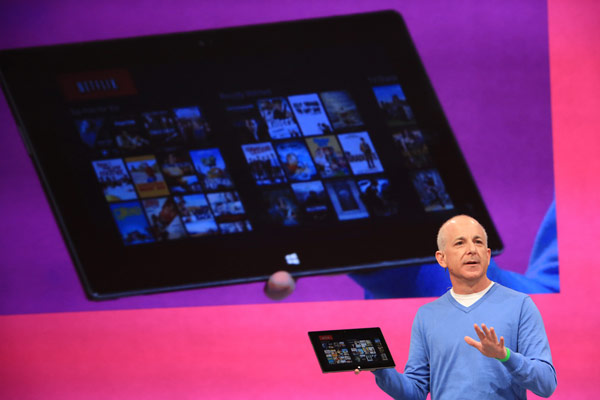
Microsoft has a longstanding tradition of promoting executives responsible for Windows soon after a new version releases. But in a stunning turnabout, Windows & Windows Live president Steven Sinofsky is finished, gone effective immediately, according to a late-evening announcement by Microsoft. To say I'm stunned is an understatement.
Sinofsky is the architect responsible for Windows 8 and RT, which launched on October 26. The backstory here must be something. Consider the timing, less than three weeks later. There's no transition. It's typical for Microsoft senior executives to go gracefully over X number of months following an announcement like this. Yet he's gone, as if fired or departed following a power play. I have no inside scoop at the moment, but will seek answers to the question many people will ask: "What now?" Sinofsky's departure forebodes during a crucial product launch.
Ballmer takes Charge
The wake of his departure perhaps reveals something. Julie Larson-Green and Tami Reller will step up. Larson-Green is promoted, now responsible for all Windows software and hardware engineering, while Reller will run Windows business operations as divisional CFO and chief marketing Officer. Both will report directly to CEO Steve Ballmer, who you could say bears overall responsibility for the Windows division now.
As someone writing about Microsoft since the mid-1990s, the reporting structure makes me suspicious about internal power struggle that went against Sinofsky or worse signs Surface and Windows 8/RT launches aren't going nearly as well as planned. Remember, Microsoft takes huge risks with the Modern UI and other changes affecting enterprise customers, OEMs and software developers.
"I am grateful for the many years of work that Steven has contributed to the company", Ballmer says. "The products and services we have delivered to the market in the past few months mark the launch of a new era at Microsoft". But he says something that hints of the behind-the-scenes drama: "To continue this success it is imperative that we continue to drive alignment across all Microsoft teams, and have more integrated and rapid development cycles for our offerings".
In reading that statement, I immediately wondered "Who's next?" and what other possible changes will come. If Sinofsky, who seemed untouchable, can leave "immediately" no one is safe, if Ballmer demands more accountability and cooperation.
Mini-Microsoft, the profile anonymous employee blogger, asks: "A Microsoft without Sinofsky?" And answers: "People walking the hallways tonight at work certainly can't believe it. I can't believe it - working at a Microsoft without Sinofsky? Inconceivable".
Post-PC Crisis
Certainly Windows has fallen on hard times, even as the new version promises (and risks) so much. During calendar third quarter, weaker than-expected PC demand pounded Windows & Windows Live division. Revenue fell by 33 percent and income by a stunning 50 percent. In a remarkable turnabout and indication just how weak is the PC market, Microsoft's Server & Tools division generated more revenue and income -- a first -- than Windows & Windows Live. Many factors have hurt PC sales, but most analysts consider competition from so-called post-PC devices, like smartphones and tablets, to be major contributing factor.
Sinofsky reveals nothing, simply stating: "It is impossible to count the blessings I have received over my years at Microsoft. I am humbled by the professionalism and generosity of everyone I have had the good fortune to work with at this awesome company".
One question on my mind: Who stands by Windows and who looks beyond it? Last month, Ballmer recast Microsoft as a "devices and services" company. Sinofsky has seen the world through Windows for a long time. Peering into my crystal ball, a scenario where the men disagreed about Windows' future and remarkably changed role wouldn't surprise me. Sinofsky protects his Windows turf, while Ballmer positions the operating system as part of a broader post-PC strategy.
Fallen Hero
Sinofsky joined Microsoft in 1998 and worked in various roles before his sudden departure. But it is for Microsoft's flagship operating system he is best known -- the man who saved Windows following the Vista debacle.
"If you're going to leave on a high-note, it doesn't get much better", Mini-Microsoft says. "Mr. Sinofsky got a standing ovation from the Windows team during the Company Meeting for all that he's done to take them on a multi-year journey to create Windows 7 and then hit the big multi-division reset button for Windows 8. He truly demonstrated technical leadership at its best".
Sinofsky earned his rewards. In July 2009, even before Windows 7 launched, Ballmer promoted him to divisional president, filling a long empty post.
Three years ago I wrote about his promotion:
Steven Sinofsky will be the last man standing. He turned around Windows development. But his challenge ahead will be much tougher. Windows relevance is waning. It may be Sinofsky's charge to take Windows into its sunset years. More immediately, he must make a last stand against the "Internet Tidal Wave" Microsoft cofounder Bill Gates wrote about in May 1995.
I predict that Windows' decline is inevitable. No Windows president can stop the tidal wave. But perhaps Sinofsky can guide Windows to ride that wave one last time.
The last man is gone, washed away by the Internet Tidal Wave that is now the post-PC tsunami.

